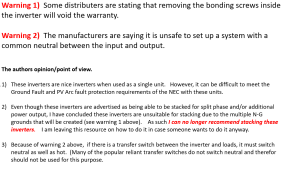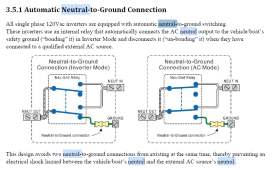None that I have seen.
Go to minute 2:30Are there any instruction or manual on how to remove the NG bonding screw from which location?
I still never get any reply from them whether by phone or email


None that I have seen.
Go to minute 2:30Are there any instruction or manual on how to remove the NG bonding screw from which location?
I still never get any reply from them whether by phone or email


Hi FilterGuy, thank you so much for all your contributions on this forum and the awesome resources you created on grounding.If I had to pick one, I would say no N-G bonds is worse than multiple N-G bonds.
First.... the best answer is and always will be one and only one NG bond in the system. Anything else is not a good idea.Hi FilterGuy, thank you so much for all your contributions on this forum and the awesome resources you created on grounding.
Could you please elaborate on the above comment? My understanding is below:
With two N-G bonds, grounded enclosures in the path will be partially energized creating a shock hazard.
With no N-G bond, we have two hots instead of a hot and a neutral as their potential to the ground is unknown. As there is no path through earth to the source, the shock hazard should be low. If we have a ground fault, we will basically create an N-G or Hot-G bond. The latter would inverse the outlets polarity creating a dangerous situation for devices relying on polarized plugs. It would take a second ground fault to close the circuit and trip a breaker.
In short, it appears it takes a ground fault to create a safety hazard without an N-G bond while a safety hazard may always between two N-G bonds.
Let me know what I'm missing!
This is what I thought initially as well but then realized that for a a battery-powered inverter without an N-G bond there is no path to the source through earth so the hot touching a grounded case may not be a shock hazard as the current has no path through a person back to the source. This is very different with utility power as the curbside transformer is grounded so there is always a path back to the source through earth.Without an NG bond, if hot shorts to a metal case or other conductive object that is grounded, The item will be hot but nothing will clear the fault. This means the object will remain a shock hazard indefinitely.
What hapens in pass-through mode? wouldn't that tie hot to ground?Coming back to the case of a battery-powered inverter, it appears to me that a hot-to-ground contact could simply result in setting the black wire as the neutral wire, as the black wire will now be at the reference ground potential, and the white wire as the hot wire correspondingly. In short, a polarity swap on the outlets but the grounded enclosure is not actually energized as it can be with multiple N-G bonds.

If I thought the NEC requirements were unnecessary, I would agree. However, the NEC requirements are not superfluous. They are there because of real problems (and deaths) that have been seen in real installations.I think the solution for the NEC issue is to change NEC, not stop using new technologies. The problem is the code, not the safety of the inverters.
There are certain places where the NEC gets it wrong, but I am not convinced this is one of them.I would argue against the NEC guidelines on loops as they are developed with a grid centric and a one size fits all solutions. My problem with them is in the name of safety they pound every peg into a round hole regardless of the cost and likelihood of incident in specific circumstances.
Yes the situation is very different in pass-through as we can assume that we always have an N-G bond at the main panel so a ground fault (hot to ground) will trip a breaker. I guess one could speculate that if pass-through mode is regularly used then it can prevent a fault going unchecked even if an N-G bond is missing in battery-powered mode.What hapens in pass-through mode? wouldn't that tie hot to ground?
Interesting. Acording to this manual the Global LF Series does internal dynamic bonding.For inverter/chargers that do not bond N-G internally (as the AIMS LF-series I'm trying to install), one could achieve the correct N-G bonding with a relay at the subpanel triggered by the AC-input to the inverter/charger although it will not be completely in sync with the built in transfer switch so there will be some incorrect transients.

AIMS has a large number of LF inverter variants. The ones with model numbers ending in V, VR, or VS have dynamic N-G bonding, which can be disconnected. The ones with model numbers ending in AL do not have dynamic N-G bonding, with the neutral floating in inverter mode. I had incorrectly assumed that they would be operating in common neutral as a result, with only the hot disconnected by the built in transfer switch. I have asked if they can be operated in common neutral with the input and ouput neutrals connected externally but have not heard back yet.Interesting. Acording to this manual the Global LF Series does internal dynamic bonding.
View attachment 123593
Coming back to the case of a battery-powered inverter, it appears to me that a hot-to-ground contact could simply result in setting the black wire as the neutral wire, as the black wire will now be at the reference ground potential, and the white wire as the hot wire correspondingly. In short, a polarity swap on the outlets but the grounded enclosure is not actually energized as it can be with multiple N-G bonds.
Do you disagree with the above?
To illustrate your point - A couple years ago I was melting lead on a hot plate and got a mild shock. I checked and it was about 50 volts to ground (in the US, 120vac line). I presumed electricity was leaking through the heating coil but not a true/full short. So I replaced the cord with a grounded cord and grounded the frame of hot plate. I assume the hot plate leaks a bit to ground now, but doesn't zap me anymore.Go to anyone's house in the US and put a clamp meter on a ground. I bet you 99 times out of 100 there's current going through it because our world is imperfect.


